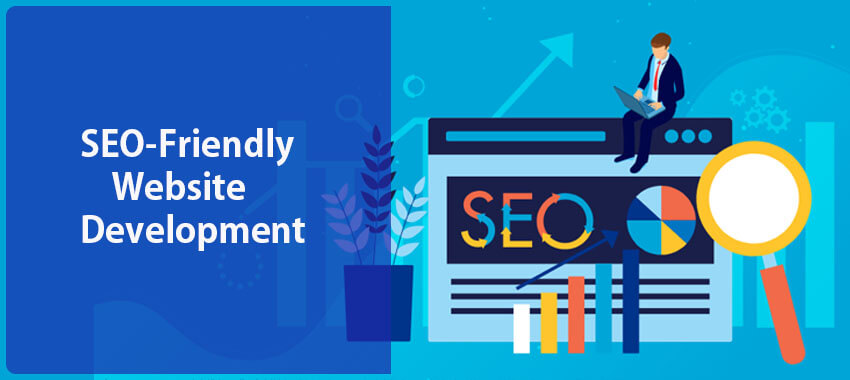Do you want to drive maximum traffic on your website? Then you need to focus on SEO-driven website development right now! In this blog, we’ll discuss all the crucial elements required or SEO-friendly website development, that help you rank it higher on SERPs.
According to databox research, 67% of all clicks go to the first five organic results, and 70% of digital marketers say that SEO is more effective at driving sales than PPC. Putting your users first is imperative and always advisable, but neglecting search engines (especially Google because it holds 86% of the search engine market) can cause you a huge traffic loss.
Therefore, it’s crucial to emphasize all the aspects of developing an SEO-friendly website and look for a trusted SEO web developer who can create a website keeping users and search engine optimization in mind. Thus, helping you gain first page rankings in search engines and increase in organic traffic.
What is SEO in website development? How do I make my website SEO-friendly that can rank higher in search results? Is SEO necessary for my website to rank higher in search engines? Even if you know everything about web development, you must consider these questions before building an SEO-ready website.
What Is an SEO-Friendly Website Development and Why Do You Need It?
Planning, designing a website, and coding it while keeping the search engine guidelines in view, and making the website user friendly is SEO-friendly website development. In simpler words, SEO-friendly websites are fully accessible and indexable by search engines, making it easy for search engines to crawl, understand the structure, rank the website, attract users, and provide an incredible user experience.
But why do you need an SEO-friendly website? There’s been quite a bit of debate as to what constitutes effective SEO and web development. In layman’s terms, SEO-friendly websites increase your organic traffic, make your website more user-friendly, have better ROI, give your brand recognition and credibility, and help you understand the user intent.
How to Build SEO-Friendly Websites? Proven Tips and Ideal Process
Market Research
The careful and in-depth market research gives you a competitive advantage over others. Market research before website development plays a vital role in building a successful website. It enables you to know your users’ behavior, explore the latest UI/UX design trends, understand your audience, and more. A data-driven website helps build the right pages, sections, and architecture, which can drastically enhance your website’s SEO.
Keyword Research
Keyword research is a crucial step in developing an SEO-friendly website. It provides valuable insight into queries that your target audience is searching online. Using the right tools can help you find relevant and insightful keywords (searched terms) related to your business and users’ intent. Thus, it helps plan the proper structure of your SEO-friendly website.
Competitors Research
Researching and understanding your competitors are a fundamental part of successful SEO-friendly website development. Pick the right competitors, analyze their content, pages, and sections fully to understand what works for them. Always keep an eye on the websites that rank higher than you, derive the information you feel is useful for your users, and apply all the insights into your web development.
Wireframing Pages
Create a wireframe that encompasses navigation, functionality, page content, and potential usability based on your competitors’ research, but better than them. Creating a physical structure (wireframe) is a good strategy and can work wonders for your SEO website development. Wireframes give you a clear view of your website’s content arrangements, strengthen your site structure, and more.
Design and Development
Our comprehensive guide on website design will help you understand how and why designing websites and developing them with the search engine friendly approach takes a considerable amount of effort, depending on several factors:
- Emphasizing Responsive and User-Friendly Design – Developers should leverage responsive and user-friendly practices to design a website that can drive leads and sales, thus improving user experience.
- Prioritizing UX – Focusing on user-experience helps you offer enhanced look, feel, and usability to your potential users, thus catering to their specific needs.
- Centering SEO-Friendly Web Navigation – SEO-friendly web navigation improves crawling, makes visitors happy, results in more page views, and better website conversions.
- Focusing on Readability – Ensure high website readability to keep people on your site longer and let them efficiently read, absorb, understand, and take information from the written content.
- Acquiring Unique Domain Name – Aiming for short, memorable, unique, and brand-centric domain name adds credibility to your business and helps you create a successful web presence.
- Creating User-Friendly URLs – Well-optimized URLs are crucial for SEO and user experience, helping visitors remember the web address and describe the pages to search engines well.
- Picking SEO-Friendly CMS – Choosing the SEO-friendly CMS can be an all-in-one solution for website content creation and management, thus ensuring the optimum look and functionality.
Major On-Page Optimization Strategies to Leverage Right Now for SEO and Web Development
Optimize Page Loading Time
Your website’s load time directly impacts your SEO-friendliness. One second delay in page response can result in a 7% reduction in conversions, so if your website doesn’t load faster, users are more likely to shift to your competitors’ site. Therefore, optimizing page load time can drastically increase the conversions.
Include Relevant Keywords in Web Content
Conducting keyword research, choosing the relevant keywords that accurately describe the page content, and using them in the right places on the website are some of the proven on-page SEO strategies you should start implementing right now. Optimizing keywords in content can help but stuffing them in headings, content, and everywhere else can do more harm.
Optimize Header Tags for Search Engines
Optimize title tags, canonical, hreflang, lang, header tags, meta descriptions, image alt tags, and others correctly for search engines to boost site visibility and clicks. Integrate your target keywords into them and help search engines understand your page’s context, thus helping you rank for those keywords.
Leverage Interlinking for Crawling and Indexing
Interlinking is one crucial aspect, yet the most overlooked part of SEO. The practice of interlinking helps search engines crawl and index your web pages in the search results. It is advisable to use relevant anchor text that gives a preview to the link’s context to see interlinking success.
Apply W3C Guidelines
W3C validation is one of the most critical factors to be considered while developing SEO-friendly websites. It helps make websites code formatted as per the web guidelines and improve web pages’ technical quality.
Google Webmaster Guidelines
Google webmaster guidelines can be a perfect place to learn and improve your websites’ usability and strengthen the user-experience. The guidelines also emphasize webmasters’ actions to make their websites more indexable, including content and design, technology, quality guidelines, AMP pages, and more.
Use Redirects
Redirect is a way to forward visitors and search engines from one URL to another when the content moves to a new URL, gets deleted, the domain changes, or website merges. Redirects are essential for great user experience and to make search engines understand that the content has moved.
Use robot.txt to Control Crawling
Whether it’s a small website or a large one, robot.txt is integral. It helps webmasters instruct search engines to visit a website’s required resources and block crawling of other content on hosting. Thus search engines can focus on crawling the essential files instead. But, make sure that you don’t block any file from the crawler required to understand your website.
Create XML Sitemap
XML Sitemaps act as a roadmap of your website that leads Google to all your important pages. They are vital from an SEO web development point of view because they make it easier for Google to find your web pages, thus dramatically improving your SEO game.
Website Testing
Your website might look great, but it may cause a huge business problem if it doesn’t function properly. Website testing optimizes server performance and functionality and ensures that your users won’t get tripped up, offering them a smooth experience.
Final Words!
SEO-friendly website development comes with certain features and characteristics that help your brand appear in more relevant search results. An SEO-friendly website increases the chances of achieving better rankings in the SERPs, thus helping your business drive massive traffic, leads, conversions, and business growth.



2 Responses
Nice blog. Very helpful. Thanks for providing this kind of content about website development. Also, I am looking forward to seeing more informative content.
Nice blog. Very helpful. Thanks for providing this kind of content about website development. Also, I am looking forward to seeing more informative content.